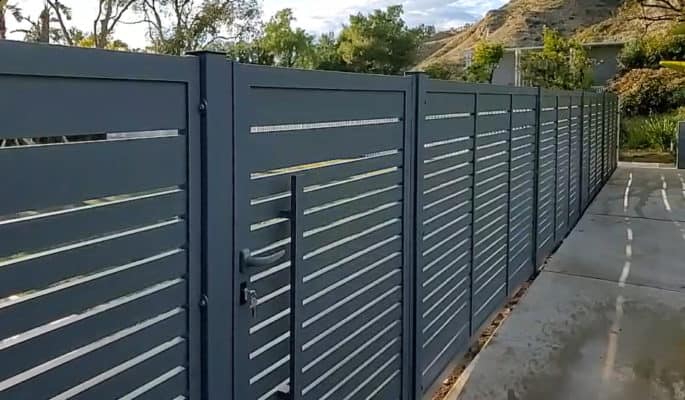The cost of having a fence installed on the property can vary significantly, depending on the type of fencing material and installation option chosen. Wooden fences are generally the most expensive, as they require more maintenance and must be replaced every 5-10 years. Chain link fencing is one of the least expensive options, but it can also become very costly when a thicker gauge wire is used or when additional features, such as privacy slats, are added. Vinyl fencing tends to be the middle-of-the-road choice in terms of cost and is known for its durability – it rarely needs replacing or repairs over its lifetime.

Professional installation can add considerable costs to any fencing, but DIY installation may save you money in the long run, depending on your skill level and access to proper tools. Additionally, labor costs can be reduced by using pre-fabricated panels that only need posts dug and placed rather than customizing each board or panel. It’s essential to consider the upfront costs and potential long-term expenses, such as upkeep and repairs, when deciding which type of fence is best for you.
Suppose you’re looking for something decorative and want to make a statement with your property. In that case, wrought iron may be an option worth considering – although this material comes at a premium price point compared to other fencing materials. All in all, many factors should be considered when budgeting for a fence project – from material selection and size requirements to labor costs and logistical challenges like underground utilities that may affect installation time or expenses.
Do fences raise the property value?
Yes, fences can raise the property value from 5% to 15%. Usually, fence material and maintenance determine property value increase. For example, if the home is worth $100 000, a well-designed fence can increase up to $15.000 in property value.
As homeowners, we often look for ways to increase the value of our property. Installing a fence is one tactic that is frequently employed in this pursuit, but does it work? The answer is yes—fences can raise the value of a home, both aesthetically and financially.
Aesthetically speaking, fences can enhance a landscape by providing structure and definition to an outdoor space. From low-level picket fences to tall privacy walls, there are plenty of styles and materials to choose from, so whatever your design preferences, maybe there’s sure to be something that suits your taste. Additionally, many municipalities have rules regulating height limits for fences on private property, so check with local ordinances before deciding on a fence style.
Fence costs Table for year 2023:
| Average Cost of Podiatry Visits by State in $ | Minimum $ | Maximum $ |
|---|---|---|
| Alabama | 75 | 110 |
| Alaska | 101 | 149 |
| Arizona | 84 | 125 |
| Arkansas | 74 | 109 |
| California | 92 | 137 |
| Colorado | 82 | 120 |
| Connecticut | 89 | 132 |
| Delaware | 87 | 128 |
| D.C. | 86 | 127 |
| Florida | 82 | 121 |
| Georgia | 77 | 114 |
| Hawaii | 78 | 115 |
| Idaho | 76 | 112 |
| Illinois | 86 | 126 |
| Indiana | 78 | 115 |
| Iowa | 71 | 105 |
| Kansas | 74 | 109 |
| Kentucky | 75 | 111 |
| Louisiana | 84 | 123 |
| Maine | 76 | 112 |
| Maryland | 89 | 131 |
| Massachusetts | 91 | 135 |
| Michigan | 84 | 124 |
| Minnesota | 95 | 140 |
| Mississippi | 76 | 112 |
| Missouri | 75 | 111 |
| Montana | 78 | 115 |
| Nebraska | 76 | 113 |
| Nevada | 81 | 119 |
| New Hampshire | 81 | 119 |
| New Jersey | 98 | 144 |
| New Mexico | 75 | 110 |
| New York | 92 | 136 |
| North Carolina | 82 | 121 |
| North Dakota | 82 | 121 |
| Ohio | 77 | 114 |
| Oklahoma | 82 | 121 |
| Oregon | 84 | 124 |
| Pennsylvania | 87 | 128 |
| Rhode Island | 92 | 136 |
| South Carolina | 79 | 116 |
| South Dakota | 74 | 109 |
| Tennessee | 74 | 110 |
| Texas | 80 | 118 |
| Utah | 83 | 123 |
| Vermont | 82 | 121 |
| Virginia | 80 | 118 |
| Washington | 89 | 131 |
| West Virginia | 80 | 118 |
| Wisconsin | 84 | 124 |
| Wyoming | 82 | 121 |
When it comes to finances, an attractive fence can raise the value of a home. According to Zillow’s 2018 analysis of landscaping projects, “The average return on investment for installing a fence is 74 percent of the total cost of installation. For example: If you spend $1,000 on fencing materials and labor costs, you could recover up to $740 when you sell your home.” Combined with the aesthetic benefits mentioned above, it’s easy to see why investing in fencing is such a smart move for any homeowner looking to add value to their home.
In addition to increasing the overall value of your property, adding a fence also has positive implications for other elements—security and privacy. Suppose you live in an area with high crime rates or want more seclusion from neighbors or passersby. Installing a fence is an excellent way to provide these benefits without sacrificing aesthetics or breaking your budget.
When considering which type of fence would best serve you and your family’s needs, there are some factors to consider, such as cost (materials vs. labor), desired style/height/color/materials used (wood, vinyl, or metal), local codes/restrictions, etc. You may even want to consult with professionals who specialize in this area before committing anything so they can give you advice based on their experience in this field and ensure that all bases are covered when it comes time for installation—after all, you don’t want any surprises afterward!
To learn more about How to Calculate Land Value, you need to analyze our articles :
- Does Rezoning Increase Property Value?
- Does Clearing Land Increase Property Value?
- Does a Barn Increase Property Value?
- Do Fences Raise the Property Value?
- How much does a shed add to property value?
- How Much Does an ADU Increase Property Value?
- How Much Does a Guest House Increase Property Value?
- Does a New Roof Increase Property Value?
- How Does Subsidence Affect Property Value?
- How Much do Power Lines Decrease Property Value?
Overall installing fencing around your property provides both tangible financial benefits as well as intangible ones like increased security and privacy along with improved aesthetics—all important considerations when thinking about raising the value of your home. Whether you are looking to rebuild an existing structure or start fresh with something new, researching options beforehand will ensure success down the road!
